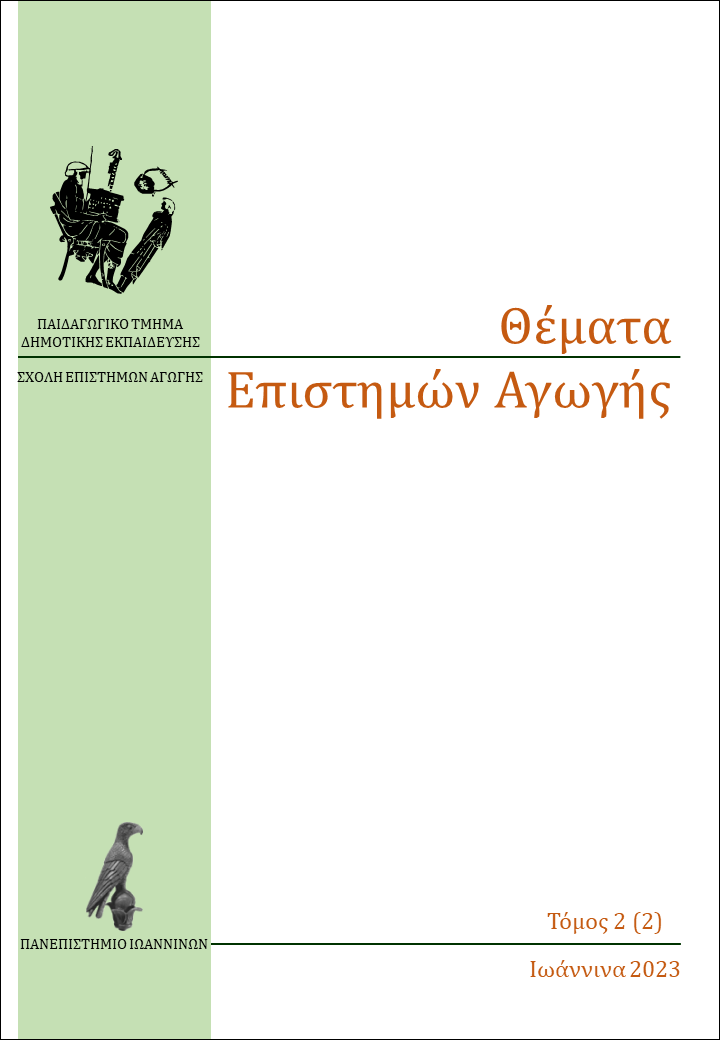Η σχέση του δείκτη καλύτερης ζωής (better life index) και του δείκτη δημοκρατικότητας (democracy index): Ένα μοντέλο πολλαπλής παλινδρόμησης
Résumé
Στην έρευνα αυτή παρουσιάζεται ένα μοντέλο πολλαπλής παλινδρόμησης με εξαρτημένη μεταβλητή το δείκτη δημοκρατικότητας και ανεξάρτητες επιμέρους μεταβλητές του δείκτη καλύτερης ζωής από τον ΟΟΣΑ. Στόχος είναι η διερεύνηση των λόγων για τους οποίους χώρες με παρόμοια εκπαιδευτικά συστήματα και αρκετά χρόνια υποχρεωτικής εκπαίδευσης κατέχουν χαμηλές θέσεις στο δείκτη δημοκρατικότητας. Στα αποτελέσματα συμπεριλαμβάνονται η ποιοτική διαφοροποίηση της παρεχόμενης εκπαίδευσης και η μεγάλη σημασία της ολοκλήρωσης των σπουδών.
Article Details
- Comment citer
-
Παπαοικονόμου Α. (2023). Η σχέση του δείκτη καλύτερης ζωής (better life index) και του δείκτη δημοκρατικότητας (democracy index): Ένα μοντέλο πολλαπλής παλινδρόμησης. Θέματα Επιστημών Αγωγής, 2(2), 67–79. https://doi.org/10.12681/thea.34431
- Numéro
- Vol. 2 No 2 (2023)
- Rubrique
- Επιστημονική Αρθρογραφία
Οι συγγραφείς των άρθρων που δημοσιεύονται στο περιοδικό διατηρούν τα δικαιώματα πνευματικής ιδιοκτησίας επί των άρθρων τους, δίνοντας στο περιοδικό το δικαίωμα της πρώτης δημοσίευσης. Άρθρα που δημοσιεύονται στο περιοδικό διατίθενται με άδεια Creative Commons 4.0 και σύμφωνα με την άδεια μπορούν να χρησιμοποιούνται ελεύθερα, με αναφορά στο/στη συγγραφέα και στην πρώτη δημοσίευση για μη κερδοσκοπικούς σκοπούς και με δικαίωμα τροποποίησης μόνον με παρόμοια διανομή (αν αναμείξετε, τροποποιήσετε, ή δημιουργήσετε πάνω στο υλικό, πρέπει να διανείμετε τις δικές σας συνεισφορές υπό την ίδια άδεια όπως και το πρωτότυπο).
Téléchargements
Les données relatives au téléchargement ne sont pas encore disponibles.
Références
Almond, G., & Verba, S. (1989. 1st ed. 1963). The civic culture: Political attitudes and democracy in five nations. Sage Publications.
Anselin, L. (1999). The future of spatial analysis in the social sciences. Geographic Information Sciences, 5, 67–76.
Anselin, L. (2002). Exploring spatial data with DynESDA2, CSISS and spatial analysis. Laboratory University of Illinois, Urbana-Champaign.
Baltagi. B., Song, S.H., & Koh, W. (2000). Testing panel data regression models with spatial error autocorrelation. Working Paper. Dept. of Economics. Texas A&M University.
Barro, R. J. (1999). The determinants of democracy. Journal of Political Economy, 107, 158–183.
Bickerton, C. & Accetti, C. (2021). Technopopulism: The new logic of democratic politics. Oxford University Press.
Bickerton, C. (2016). The European Union: A citizen’s guide. Pelican Books.
Cartledge, P. (2016). Democracy: A life. Oxford University Press.
Carretero, M., Haste, H., & Bermudez, A. (2016). Civic education. In L. Corno & E. M. Anderman (Eds.), Hand-book of Educational Psychology (pp. 295–308). Routledge/Taylor & Francis Group.
Carvalhosa M.V. (2018). What is a better life? OECD's better life index explores quality of life. OECD Forum.
Coppedge, M. (2005). Defining and measuring democracy. Working paper. International Political Science Associa-tion.
Crouch, C. (2020). Post-Democracy after the crises. Polity Press.
Dahl, R. (1970). Polyarchy. Yale University Press.
Daron, A., Johnson, S., Robinson, J.A., & Yared, P. 2005). Income and democracy. NBER Working Paper No. 11205.
Δείκτης Δημοκρατικότητας, (2022) https://www.eiu.com/n/campaigns/democracy-index-2022. Τελευταία πρό-σβαση 8/5/2023.
Diamond, L., & Plattner, M. (Eds.) (2016). Democracy in decline? John Hopkins University Press.
Fukuyama, F. (2011). The origins of political order: From prehuman times to the French, Verso.
Fuller, R. (2019). In defence of democracy. Polity Press.
Glaeser, E., LaPorta, R., Lopez-de-Silanes, F., & Shleifer, A. (2004). Do institutions cause growth? Journal of Eco-nomic Growth, 9, 271-303.
Glaeser, E.L., Ponzetto, G., & Shleifer, P. (2005). Why does democracy need education? Harvard University and NBER.
Horowitz, I.L. (2006). The struggle for democracy. National Interest, 83.
Iverson, T., & Soskice, D. (2019). Democracy and prosperity: Reinventing capitalism through a turbulent century. Princeton University Press.
Kasparian, J., & Rolland, A. (2012). OECD's 'better life index': Can any country be well ranked? Journal of Ap-plied Statistics, 39(10), 2223–2230. doi:10.1080/02664763.2012.706265. S2CID 56123147.
Kekic, L. (2007). The economist intelligence unit’s index of democracy. The world in 2007, economist, revolution. Profile Books.
Koronakos, G., Smirlis, Y., Sotiros, D., & Despotis, D. (2019). Assessment of OECD better life index by incorpo-rating public opinion. Socio-Economic Planning Sciences, 70, 100699. doi:10.1016/j.seps.2019.03.005. S2CID 159351542. Retrieved 30 December 2021.
LeSage, J.P., & Pace, R.K. (2005). Spatial and spatiotemporal econometrics. Volume 18 (Advances in Econometrics). JAI Press.
Levitsky, S. & Daniel Z. (2018). How democracies die: What history reveals about our future. Penguin.
Lipset, S. M. (1959). Some social requisites for democracy: Economic development and political legitimacy. Amer-ican Political Science Review, 53, 69-105.
Luce, E. (2017). The retreat of western liberalism. Little, Brown.
Papaioannou, E., & Siourounis, G. (2005) Economic and social factors driving the third wave of democratization. Mimeo, London Business School.
Przeworski, A., Alvarez, M., Cheibub, J.A., & Limongi, F. (2000). Democracy and development: Political institutions and material well-being in the world, 1950-1990. Cambridge University Press.
Przeworski, A. (2019). Crises of democracy. Cambridge University Press.
Ribon, R., & Dani. R. (2005). Rule of law democracy, openness, and income: estimating the interrelationships. Economics of Transition, 13(3).
Rogers, S. (2012, May 22). Better life: relaunching the happiness index. The Guardian.
Youngs, R. (2019). Civic activism unleashed: New hope or false dawn for democracy? Oxford University Press.
Youngs, R. (2021). Rebuilding European democracy: Resistance and renewal in an illiberal age. Bloomsbury Publishing.
Zielonka, J. (2018). Counter-revolution: Liberal Europe in retreat. Oxford University Press



